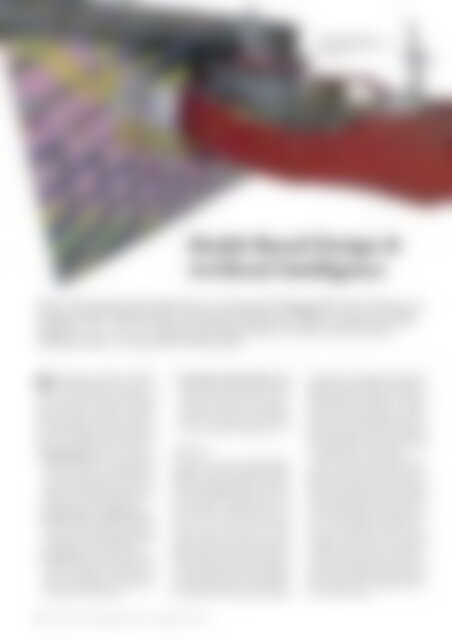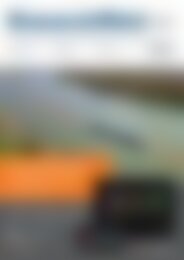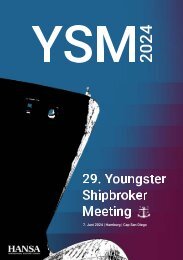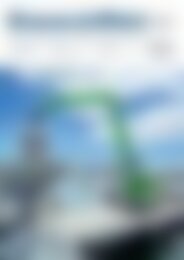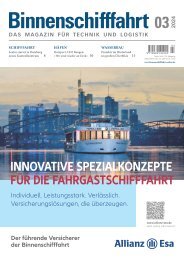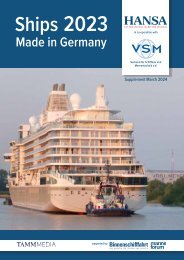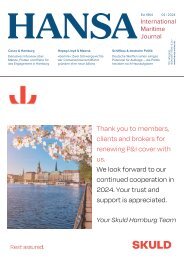HANSA 04-2018
Aktien & Börsen | Marktkompass Offshore | Wasserbau & Planungsrecht | Datenbrillen im Schiffbau | COMPIT 2018 | Fährschifffahrt | Arktische Schifffahrt | Hafnia
Aktien & Börsen | Marktkompass Offshore | Wasserbau & Planungsrecht | Datenbrillen im Schiffbau | COMPIT 2018 | Fährschifffahrt | Arktische Schifffahrt | Hafnia
Sie wollen auch ein ePaper? Erhöhen Sie die Reichweite Ihrer Titel.
YUMPU macht aus Druck-PDFs automatisch weboptimierte ePaper, die Google liebt.
Schiffstechnik | Ship Technology<br />
From concept to reality –<br />
Seamless modelling seems to be<br />
within grasp<br />
Model-Based Design &<br />
Artificial Intelligence<br />
What is behind trends like Digital Twin or Autonomous Shipping? The 17th Conference on<br />
Computer and IT Applications in the Maritime Industries (COMPIT) will give an insight.<br />
Organizer Volker Bertram of Tutech Innovation presents an exclusive preview of the<br />
conference held 14–16 May <strong>2018</strong> in Pavone, Italy<br />
Over the past two decades, COMPIT<br />
has established itself as a key conference<br />
in information technology (IT)<br />
for the maritime industries, bringing<br />
together software developers and users.<br />
Most participants come from the industry,<br />
reflecting the practical relevance of<br />
the event. COMPIT lasts three full days.<br />
This year, the main trends, in short, are:<br />
• l Appgrades galore: Do the same tasks,<br />
but better thanks to new technologies,<br />
using apps instead of installed software,<br />
smartphones instead of 3D scanning,<br />
or Virtual Reality instead of 2D<br />
displays for training and instruction. A<br />
lot of the progress is evolutionary.<br />
• l Cradle-to-grave model-based processes:<br />
From early design to ships in<br />
service, product life-cycle management<br />
is model-based. The Digital Twin grows<br />
and evolves as the real ship does.<br />
• l AI embraced: Assorted new developments<br />
use the power of Big Data and<br />
Artificial Intelligence (machine learning).<br />
AI is embraced as a useful tool,<br />
nothing more, nothing less.<br />
• l Autonomous systems spread: While<br />
everybody waits for the unmanned ship<br />
on the horizon, under our noses a multitude<br />
of autonomous systems and robots<br />
mature to support smarter ship operation.<br />
Tear your eyes away from the<br />
horizon and grab the opportunities!<br />
Appify me<br />
If computer experts would speak plain<br />
English, we all might understand them.<br />
Which is probably a nightmare for them<br />
and will not happen in this world. So,<br />
us mere mortals better get used to some<br />
new vocabulary. »Appification« for example.<br />
The act of turning software that<br />
used to be installed on your computer<br />
into an App – software that is in the<br />
cloud and can be run from your smartphone.<br />
Actually, that is quite a smart idea<br />
and the Apps are coming also to the marine<br />
world. »Appify what can be appified«<br />
seems to be the motto this year. Palluch et<br />
al. (Friendship Systems and ISA Propulsion)<br />
describe a web-based App (webApp)<br />
for geometric modeling and design of<br />
propellers. The App builds on well-established<br />
design environment CAESES offering<br />
selected functionalities via a standard<br />
web-browser. Building on CAESES’<br />
parametric modeling techniques, a propeller<br />
is generated with just a handful of<br />
inputs. Its geometry can be downloaded<br />
in standard format descriptions, e.g. for<br />
CFD simulations or 3D printing.<br />
There are persistent rumors that smartphones<br />
are actually sometimes used for<br />
phoning other people. But surely, they are<br />
busy most of the time with these Apps<br />
or other engineering wizardry. Did you<br />
know that smartphones can replace 3D<br />
scans? This little gem is presented by Fischer<br />
et al. (Fraunhofer and Rostock University),<br />
who describe new ways of capturing<br />
the as-built state of ships. Instead<br />
of expensive laser scanners, mobile devices<br />
like smartphones are used to create<br />
point clouds and ultimately 3D models.<br />
During assembly, the 3D model of the<br />
ship as-built is then available with precious<br />
little time delay.<br />
66 <strong>HANSA</strong> International Maritime Journal – 155. Jahrgang – <strong>2018</strong> – Nr. 4


